When Alberta Premier Rachel Notley announced obligatory production cuts of 325,000 bpd in December in a bid to tackle a deep discount between Western Canadian Select and West Texas Intermediate, the market’s reaction was promising. The price of Canadian crude jumped up immediately and has been trending higher ever since, now that the cuts actually came into effect. But local oil producers are not relaxing: they are looking for ways to cut their costs further by reducing transportation expenses and they are employing new technology to do that.
Bloomberg’s Kevin Orland reported earlier this week that MEG Energy was working on commercializing a proprietary method of partial upgrading that eliminates the need to add diluent to the Alberta bitumen so it can be transported by pipeline. The HI-Q technology, as described by Orland, involves “a process that entails removing and recycling some diluent used in its initial processing, separating out the lighter and heavier portions of the bitumen, then removing solid materials known as asphaltenes.”
MEG is not alone in its anti-diluent push. Cenovus Energy and Husky Energy are also testing their own methods of reducing diluent demand. They all have a good reason for this. Diluents are typically light crude fractions and light fractions are expensive. And that’s just the start.
Diluent-related costs are multiple and include the cost of transporting it from its place of origin to where it would be added to the bitumen, then stripping it off the bitumen upon arrival at its destination, transporting it to a diluent collection hub, and from there back to its producer. All these costs really being to burn when you factor in the proportion of bitumen to diluent that makes it possible for the oil to flow through a pipeline. This ratio is 70:30 bitumen to diluent. Related: Aramco Ready To Pour Billions In U.S. Natural Gas
Given this state of affairs, the pipeline capacity shortage might actually be a blessing in disguise, at least in some aspects. For one thing, bitumen does not need diluting to be loaded on rail cars and that’s some cost savings. For another, undiluted bitumen is much harder to spill or leak, so from a certain perspective, transporting oil by rail might in fact be safer than pipeline transportation. And there is research aimed at enhancing both of these benefits.
In 2017, for example, a Canadian engineer and his team accidentally discovered a way that could make transporting heavy Alberta crude by rail much more safely. In fact, the bitumen pellets that Ian Gates and his co-workers came up with could make oil transportation safer than pipelines.
The method, which involves applying heat and pressure to the bitumen, turns bitumen into self-sealed pellets with a highly viscous coating and a liquid core. The process is as costly as adding diluent to the heavy crude, however, which is probably why it hasn’t yet been adopted on a large scale. Related: Russia’s Wealth Fund: Oil Price War With U.S. Would Hurt Russian Economy
Another method, developed by the Canadian National Railway, involves sealing solidified bitumen in plastic pucks, which goes a few steps further in terms of safety. Canadian National argues Canapux, as it has called its invention, can also be transported more cheaply than existing alternatives. It is now looking for financial partners to commercialize a pilot plant with a capacity of 10,000 bpd of the solid bitumen pucks.
The search for alternatives to diluted bitumen is on but it will probably be a while before we see any meaningful results.
“If you look at partial-processing technology, certainly it could have an effect on diluent demand in smaller volumes earlier,” IHS Markit’s North American crude oil markets chief Kevin Birn told Orland, “but to have a really large effect, I think you’re looking some period out into the future."
By Irina Slav for Oilprice.com
More Top Reads From Oilprice.com:
- Saudi Arabia: We’ll Pump The World’s Very Last Barrel Of Oil
- U.S. Set To Pump More Oil Than Russia And Saudis Combined
- BP Remains Bullish On Oil Demand Growth


















